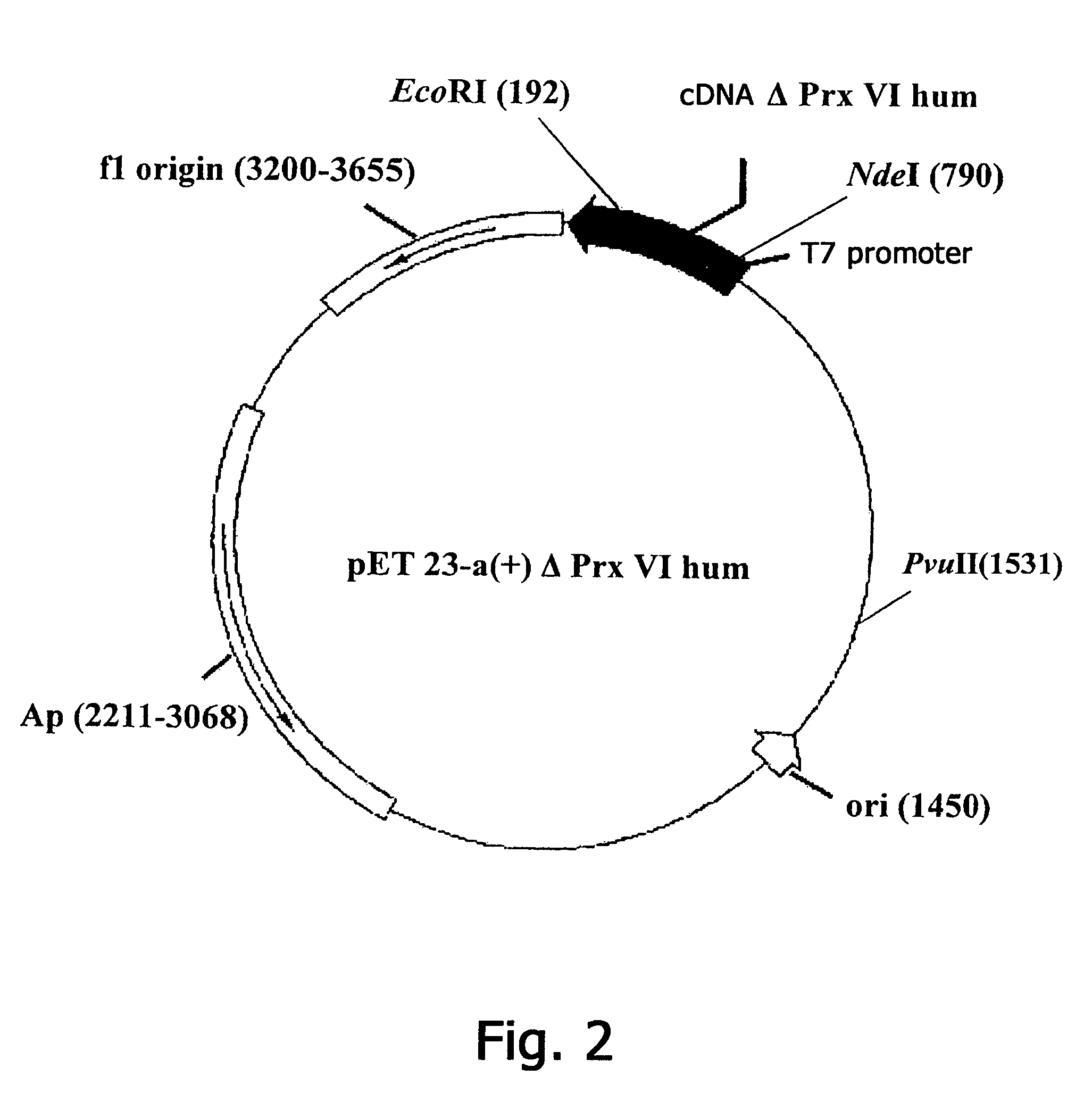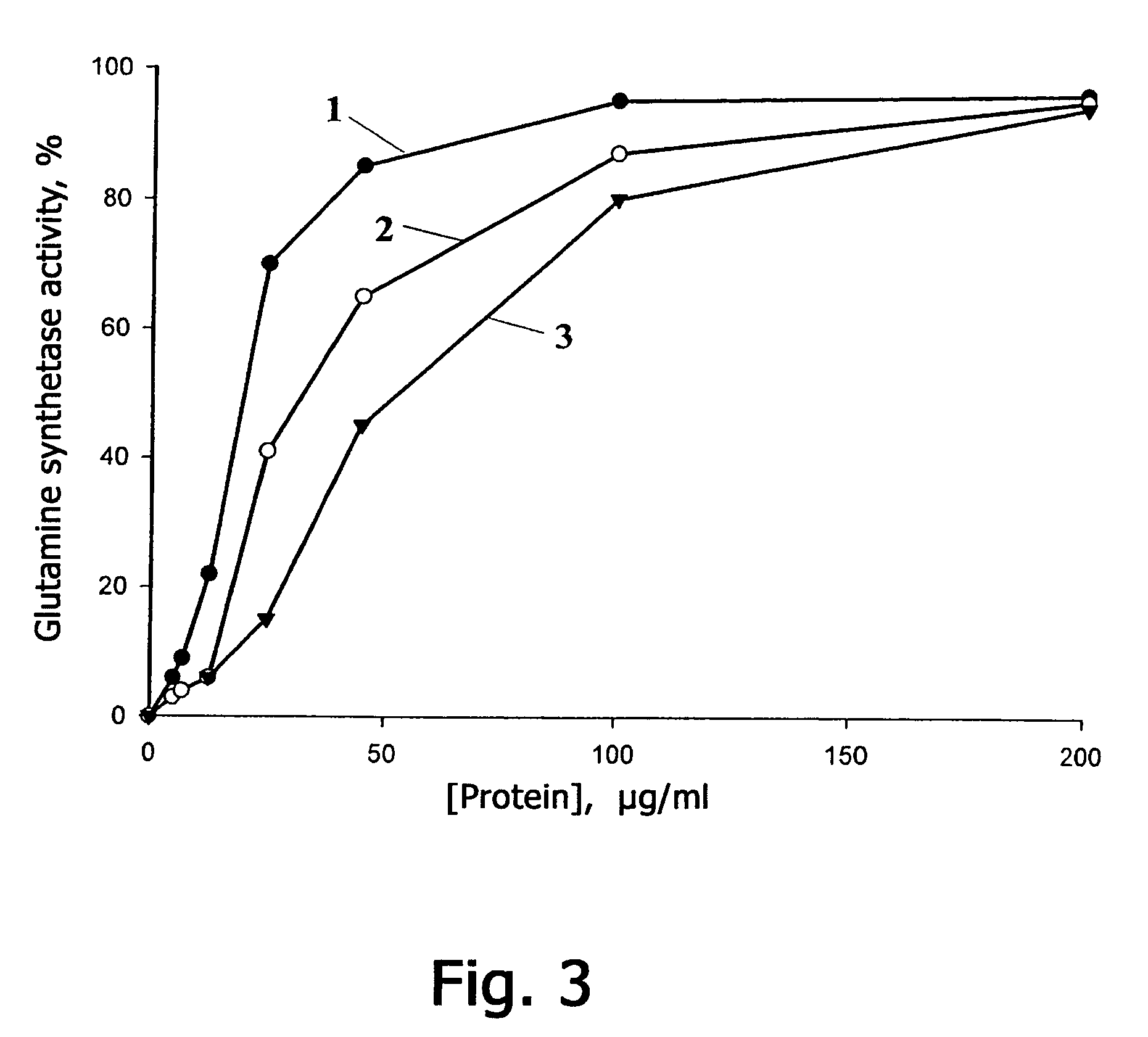Antioxidant pharmaceutical compound, method for producing polypeptide and method of cure
a technology of antioxidant pharmaceutical compound and polypeptide, which is applied in the field of medicine, biotechnology and genetic engineering, can solve the problems of not being effective in heavy pathologies, low antioxidant activity, and the origin of avalanche-like processes of cell death, so as to improve the antioxidant protection of cells, reduce the level of free radicals, and achieve similar antioxidant effectiveness.
- Summary
- Abstract
- Description
- Claims
- Application Information
AI Technical Summary
Benefits of technology
Problems solved by technology
Method used
Image
Examples
example 1
Preparing Natural Peroxiredoxin of Rat Prx Virat
[0126]Natural Prx VIrat was prepared according to the following procedure. Peroxiredoxin Prtx VIrat was isolated from the olfactory epithelium of a Wistar line rat, which contains maximum amount of this protein. The isolated olfactory epithelium was washed twice in a physiological solution and homogenized therein. The homogenate was centrifugated for 5 min at 500 g, the supernatant was again centrifugated twice at 20000 g and dialyzed for 12 hours against solution A whose formulation comprises: 12 mM of Tris / HCl, pH 7.8, 1 mM of MgCl2, 1 mM of dithiothreitol. After the dialysis the extract was applied to a chromatographic column (305×12.5 mm) filled with DEAE-Sepharose gel (DEAE-Sepharose, Pharmacia) and preliminarily balanced with solution A. Proteins were eluted with linear variation of NaCl gradient from 0 mM to 500 mM in solution A at 17° C. The volume of the solution was 750 ml, the elution rate was 0.7 ml / min. The fractions were ...
example 2
Constructing Recombinant Plasmid DNA pET23-a(+)Prx V1hum, Encoding Full-Sized Prx Vlhum
[0127]Complementary DNA encoding human peroxiredoxin Prx Vlhum (SEQ ID NO: 1) was isolated from clone HA0683 (Nagase T. et al., 1995, GenBank, D14662) by the method of polymerase chain reaction (PCR) (Taylor G., 1994), with the use as primers oligonucleotides, in whose sequences point replacements are made for corresponding restriction sites to be created. As a direct primer use is made of the sequence 5′-ATCACCCGTCCATATGCCCGGAGG-3′ (SEQ ID NO: 3) (the NdeI restrictase recognition site is underlined), as a reverse primer use is made of the sequence 5′-CCAGAATTCTTAAGGCTGGGGTGTG-3′ (SEQ ID NO: 4) (the EcoRI restrictase recognition site is underlined).
[0128]The reaction mixture for carrying out PCR contains (in the volume of 50 μl): 1 nl of plasmid DNA, 20 nmole of each primer, 5 μl of a 10-fold buffer for CPR (Promega Corporation), 200 μM of each dNTP, 5 units of Taq-polymerase. The reaction is star...
example 3
Constructing Recombinant Plasmid DNA pET23-a(+)ΔPrx V1hum, encoding N-terminal fragment of human Prx VI
[0129]The initial plasmid for constructing new sequences of DNA fragments encoding polypeptide fragments ΔPrx V1hum is the plasmid pET23-a.(+)Prx Vlhum determining the expression of full-size recombinant Prx Vlhum, which is used as a matrix for PCR. As one of the variants of a short DNA fragment, the N-terminal fragment ΔPrxVI is selected, having a length of 177 a.b. (SEQ ID NO: 2). As the direct primer use is made of the sequence 5′-GCGAAATTAATACGACTCACTATAGGG-3′ (SEQ ID NO: 5) (complementary to the promoter region of the vector pET23-a(+)ΔPrx V1hum). As the reverse primer use is made of the sequence 5′-CCATCCTTCGAATTCAACTTAGGTGGC-3′ (SEQ ID NO: 6) (the EcoRI restrictases site is underlined).
[0130]The reaction mixture contains (in the volume of 50 μl): 1 ng of plasmid DNA, 20 pmole of each primer, 5 μl of the buffer for CPR (Promega USA), 200 μM of each dNTP, 5 units of Taq-polyme...
PUM
| Property | Measurement | Unit |
|---|---|---|
| concentration | aaaaa | aaaaa |
| molecular mass | aaaaa | aaaaa |
| concentration | aaaaa | aaaaa |
Abstract
Description
Claims
Application Information
 Login to View More
Login to View More - R&D
- Intellectual Property
- Life Sciences
- Materials
- Tech Scout
- Unparalleled Data Quality
- Higher Quality Content
- 60% Fewer Hallucinations
Browse by: Latest US Patents, China's latest patents, Technical Efficacy Thesaurus, Application Domain, Technology Topic, Popular Technical Reports.
© 2025 PatSnap. All rights reserved.Legal|Privacy policy|Modern Slavery Act Transparency Statement|Sitemap|About US| Contact US: help@patsnap.com



